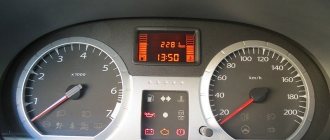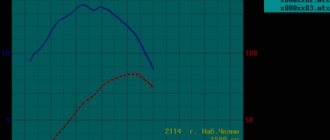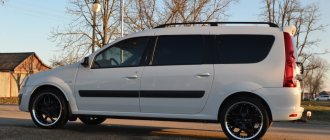Lada Largus which gasoline is 92 or 95?
Answer the question “which gasoline 92 or 95 is better in Lada Largus?” There is only one word - quality. In practice, VAZ and Renault engines work perfectly on 92 gasoline, but provided that the gasoline is of high quality and not degraded. But, we live in Russia and, alas, high-quality fuel cannot be found at any gas station. In the article on replacing the Lada Largus fuel filter, we showed what the filter element looks like after 100 thousand kilometers on our gasoline. If you use low-quality gasoline, you will have to completely drain it from the tank and change all the filters.
To at least somehow protect your car from poor-quality refueling, try to refuel only in trusted places or at network gas stations. Such gas stations monitor the quality of gasoline much more often and very rarely deal with diluted gasoline. The same cannot be said about small gas stations that resort to similar tricks to “stay afloat.”
What cars was H4M installed on?
The H4M engine was harmoniously and rationally introduced into the creation of a large number of Nissan and Renault cars and was successfully adapted to each model.
Since 2012, it has been equipped with Renault cars, such as Arkana 1 (from 2022), Fluence 1 (from 2012 to 2022), Megane 3 (from 2013 to 2016), Sandero 2, Duster 1, Kaptur 1, Megane 4 , Logan 2 and Sandero 2 Stepway (since 2016), Logan 2 Stepway (since 2018).
The following Lada cars also received this engine: X-Ray hatchback (since 2016), Vesta sedan 2180, Vesta SW 2181, Vesta Cross 2180, Vesta SW Cross 2181 and X-Ray Cross (since 2019).
Is it worth using 95 petrol Lada Largus?
Based on numerous reviews, you can see that with AI95 gasoline, the Lada Largus engine (any of the line) runs smoother and more stable, and fuel consumption is significantly reduced. But AI95 itself is more expensive than AI92. Therefore, decide for yourself what gasoline to fill your Lada Largus with. That's all, full fuel tanks everyone, thank you for your attention and see you again.
How does the car manual answer this question?
So, to answer the question of whether it is possible to fill Granta with 92 gasoline, which worries many motorists, you should open the instructions on Appendix 1, which states that the recommended gasoline is “Premium 95” or “Premium Euro 5”. Why do the instructions contain such strict restrictions regarding gasoline?
Let's figure it out. The first note states that the required flammability at low temperatures must be ensured.
It follows from this that fuel must be selected of a certain volatility class. In different regions of the Russian Federation, this requirement is adhered to differently, and fuel volatility classes differ from each other based on location.
The second obstacle to the use of low-octane gasoline is various metal and organic particles, which are anti-knock agents and are contained in gasoline. The presence of lead, cadmium, manganese, iron and other metals can be observed in the particles.
Various additive materials are introduced into high-octane gasoline to prevent the formation of soot, various deposits and corrosion. But these substances can only be included in gasoline by its manufacturer. Every motorist can do this, but experts do not recommend doing this, since substances can be introduced in the wrong proportion.
Gasoline Lada Largus according to GOST
When we arrive at a gas station, we most often pay attention only to the octane number printed on the column. However, fuel has other designations that you need to pay attention to.
For Lada Largus with French engines, it is recommended to use unleaded gasoline with an octane rating of at least AI-95. Premium-95 according to GOST R 51105 or Premium Euro-95 according to GOST R 51866 is perfect.
For Russian engines, unleaded gasoline AI92 of classes K3, K4 and K5 is perfect, for example Regular-92 according to GOST R 51105-97.
The secret of increased performance
Currently, manufacturers of Lada Largus cars indicate in the technical documentation attached to it the dimensions of their fuel tank, equal to approximately 50 liters. In fact, you can put a lot more gasoline into it. There are several reasons for this:
- relatively large fuel tank neck;
- deliberate application of a slightly smaller volume by manufacturers to comply with technical documentation;
- the presence of special voids in the tank that increase its level of wear resistance;
- errors in the operation of refueling equipment.
About the long neck
Naturally, the creators of the Lada Largus car, if possible, would indicate exactly 65 liters of fuel in the technical parameters, if they had such an opportunity. In fact, almost any car can be filled with slightly more gasoline than is indicated in the documentation. This is due to the fact that not the entire actual volume of the fuel tank is subject to accounting. The fact is that the neck is not an accounting space. At the same time, in the Lada Largus car it has increased dimensions in comparison with other models. As a result, several liters of fuel will easily fit there.
Fuel system Lada Largus
Better to play it safe
Another important point to understand is the fact that manufacturers indicate not the exact, but the approximate volume of the fuel tank. Moreover, in reality, in no case should it be smaller in size than what is written in the application from the manufacturer. It is for this reason that companies play it safe and indicate a slightly smaller fuel tank volume.
All gas stations lie
We should also not forget that unscrupulous gas stations can “increase” the amount of fuel they can hold without any problems. In fact, there are even officially indicated “miscalculations” of equipment during the process of pouring gasoline into a car. Most often we are talking about 50 ml per 10 liters. What can we say about unofficial “mistakes”.
Safety first
Another reason for such differences should be sought in the physical properties of gasoline itself. The fact is that during the heating process it expands quite strongly. So, if the fuel tank does not have additional volume, it can lead to failure. It is to avoid such excesses that any tank has special hollow protrusions. Under normal conditions, after firing the refueling nozzle, they are still empty. If you wait a little and try to continue refueling, these reserve spaces will also be filled.
Various recommendations
You can often come across this question on various automotive forums, but no one can give a clear answer. Let's try to consider and come to a conclusion, what kind of gasoline is needed for this car?
Recommendations from the AvtoVAZ plant
Which of these will we choose for Largus?
According to the service book and manufacturer's recommendations, Largus must be filled with fuel with a medium or high octane number. So, the question arises, what kind of gasoline should be poured into the tank - AI-92, AI-95, AI-98, or the Premium and Euro varieties? In the same manual about the fuel system it is written that it is not lower than AI-95. This is due precisely to the effect on the fuel system, which better perceives this particular marking.
Renault engine manufacturer's recommendations
The factory recommendations are duplicated on the gas tank flap cover (only 95 and 98)
Since the Largus has a Renault engine, you should listen to this manufacturer when choosing gasoline.
An exact definition was found in the service book for the K4M and K7J engines. The fuel system must be filled with gasoline marked at least A-95E.
To reduce consumption, the manufacturer recommends using only 92 gasoline.
This fuel is designated AI-95 Euro on the domestic market.
Expert recommendations
In 2014, this car was tested on different types of fuel. Three cars with the same characteristics, into which AI-92, AI-95 and AI-98 were poured. Each of them was tested for different indicators.
When using AI-98, the engine overheated too much and the cooling fan could not cope. Therefore, experts noted that this brand of fuel is not very suitable for use in Lada cars.
When using AI-95, there was a noticeable increase in dynamics and a drop in consumption compared to AI-92. Thus, experts noted that the ideal option is to use this particular brand of fuel.
Motorists' experience
Based on the experience of motorists, we can say that AI-95 becomes the optimal option for use. After switching to this brand from AI-92, the dynamics noticeably increased, and the consumption decreased by almost 25%, which cannot but please the owners.
Also, auto mechanics note that when using AI-95, there is less deposits on the walls of the combustion chambers, and the fuel system becomes clogged and fails much less often. Therefore, it is recommended to fill Largus with this type of gasoline.
What do car manufacturers recommend?
Many, and not without reason, believe that the manufacturers’ recommendations, which are reflected in the vehicle’s technical passport, should be strictly followed. Why is it not recommended to break them? Let's try to find out. If, according to the technical data sheet, the engine is intended for 95-grade gasoline, then some, trying to save money, fill it with 92-grade gasoline. Over time, this leads to a problem with the engine, and, naturally, through the fault of the car owner himself. According to the law of physics, the higher the octane, the lower the combustion temperature of the combustible mixture will be. But when using low-octane fuel, the opposite happens. This leads to burnout of some parts and to rapid unscheduled partial or overhaul of the engine. So, if a car must be refueled only with 95-grade gasoline, then you absolutely cannot “feed” it with 92-grade fuel, because this is fraught and you need to be extremely careful.
Source
FakeHeader
Comments 113
Good afternoon. Lew A95. Previously I tried A92, which is recommended by the manufacturer. Why did you switch to A95? 1. I don’t see any point in saving too much, since the difference in cost is small. In addition, in my opinion, the amount of 5,000 rubles. scattered over a year is absolutely miniscule. 2. I only pour gasoline at proven gas stations. It’s easier to waste money at poorly established gas stations and then argue about everything. The car drives in any case, but the driving mode on the A95 is quieter, calmer and feels more dynamic. 3. I did not specifically compare the costs of this or that gasoline. I wrote a review with personal observations about the car, including current fuel consumption after running-in. In general, I must note that my expenses, in my opinion, are quite good. I am satisfied with everything. 4. For some time now I have been keeping records of gas stations. I'll analyze the data someday. There is no time yet.
Real fuel consumption figures
Some cars are produced with 8 valves in engines. There are versions with 84 hp. and 87 hp The manufacturer promises that these cars will “eat” 10.5-10.6 liters on city streets and 6.5-6.9 liters on the highway. In reality, the values differ greatly.
For 84 hp engines. and 87 hp have approximately the same consumption in real conditions. The values are as follows:
- When driving in the city, in traffic jams and difficult traffic conditions - 12.4-13.8 l;
- If you often have to drive on the highway, between cities – 8.2-8.9 liters;
- When driving in the combined cycle - 10.1-10.9 liters.
Power plants 102 hp, 105 hp and 106 hp consume more gasoline than less powerful versions. However, the numbers are quite adequate, which contribute to fuel savings. In real conditions, the indicators are:
- Driving on city roads – 12.6-13.9 l;
- Driving on highways – 8.6-9.4 l;
- Driving both on the road and on the highway – 10.5-11.6 liters.
It must be borne in mind that consumption figures fluctuate greatly, depending on environmental conditions. In winter and at low temperatures, the specified gasoline consumption standards increase.
Those cars that are equipped with engines of 102 hp, 105 hp. and 106 hp have a basic design with 16 valves. This had a good effect on the power and dynamics of the car. Unfortunately, a negative trend towards increased gasoline consumption has emerged. For all these three engine variations, the numbers are approximately the same - we list them:
- Operating the car in the city, on a busy road – 12.5-13.6 l;
- Driving between populated areas on the highway – 8.9-9.7 l;
- Mixed operating cycle – 10.3-10.9 l.











